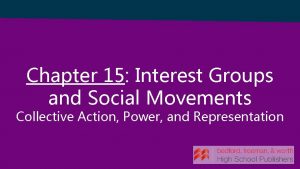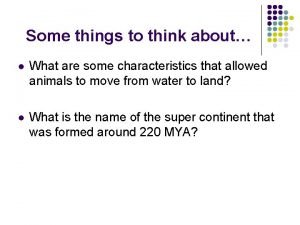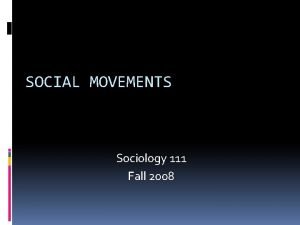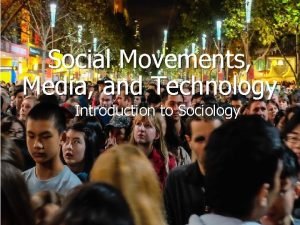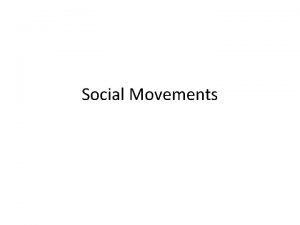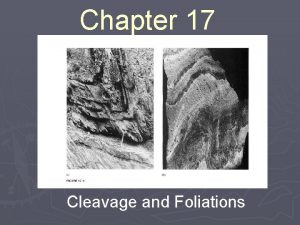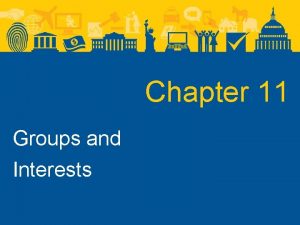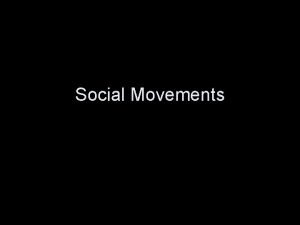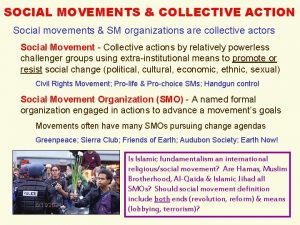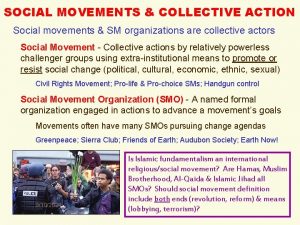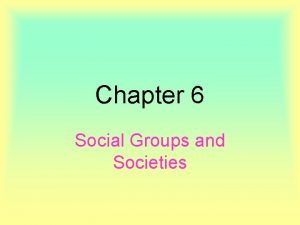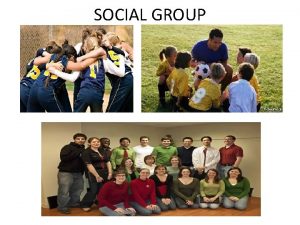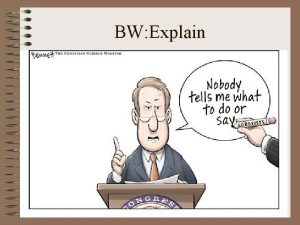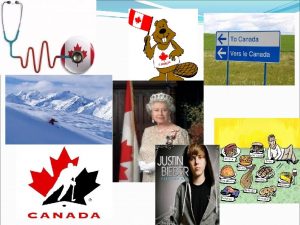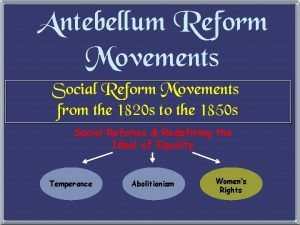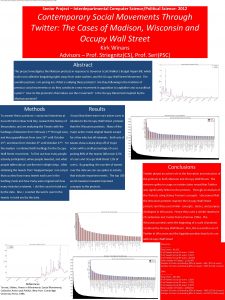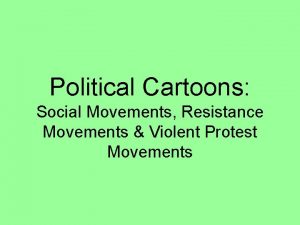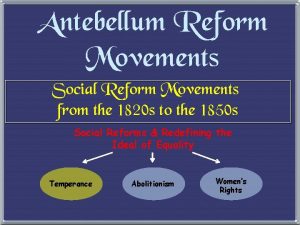Groups Interests and Movements Cleavage social division that
































- Slides: 32

Groups, Interests and Movements

• Cleavage: social division that creates a collective identity on both sides of the divide. • Association: group formed by voluntary action, reflecting a recognition of shared interests or common concerns. • Interest: that which benefits an individual or group; interests are usually understood to beobjective or ‘real’.

• communal groups • institutional groups • associational groups

Communal groups • embedded in the social fabric, in the sense that membership is based on birth, rather than recruitment. • families, tribes, castes and ethnic groups • founded on the basis of a shared heritage and traditional bonds and loyalties rather than volunteerism

Institutional groups • part of the machinery of government and attempt to exert influence • differ from interest groups in that they enjoy no measure of autonomy • Bureaucracies and the military • rivalry amongst institutional groups may become the principal form of interest articulation

Associational groups • formed by people who come together to pursue shared, but limited, goals. • Industrialization both generates social differentiation and individualized patterns of behaviour

• Interest Group – seek to exert influence from outside, rather than to win or exercise government power – typically have a narrow issue focus – seldom have the broader programmic or ideological features that are generally associated with political parties – Direct action: Political action taken outside the constitutional and legal framework

Sectional groups • exist to advance or protect the (usually material) interests of their members. • Trade unions, business corporations, trade associations and professional bodies

promotional groups • • advance shared values, ideals or principles ‘pro-choice’ and ‘pro-life’ lobbies on abortion, campaigns in favour of civil liberties NGOs: private, non-commercial group or body which seeks to achieve its ends through nonviolent means

• Insider Groups: enjoy regular, privileged and usually institutionalized access to government • Outsider groups: lacking formal access to government, these groups are forced to ‘go public’ in the hope of exercising indirect influence on the policy process


Models of group politics • Pluralist Model • Corporatist Model • New Right Model

Pluralist model • political power is fragmented and widely dispersed • Decisions are made through bargaining and interaction • ensures that the views of a large number of groups are taken into account • group politics is the very stuff of the democracy • all groups have the potential to organize and gain access to government • This highly optimistic view has been criticized by elitists and Marxists

Corporatist model • Corporatism: emphasizes the privileged position that certain groups enjoy in relation to government • Tripartitism: The construction of bodies that represent government, business and the unions, designed to institutionalize group consultation. • portrays interest groups as hierarchically ordered and dominated by leaders who are not directly accountable to members • Government by consultation may simply be a sham concealing corporatism as a mechanism of social control

New Right model • derived ideologically, from individualism that lies at the heart of neoliberal economics • Social groups are viewed with suspicion • market economy driven by self-reliance and entrepreneurialism



Patterns of group politics • • political culture institutional structure nature of the party system nature and style of public policy

political culture • determines whether interest groups are viewed as legitimate or non-legitimate • affects the willingness of people to form or join organized interests or to engage in group politics • Monoistic Regimes: Monoism, belief in only one theory or value, implicitly totalitarian • Pluralist Regimes: permit and encourage group politics

Institutional structure of government • Establishes points of access to the policy process

Party System • Dominant and one party systems allow for more limited scope of influence for interest groups that multi-party systems.

Public Policy • The degree to which government intervenes in public and social life • Interventionism: Government policies designed to regulate or manage economic life; more broadly, a policy of engagement or involvement


How do groups exert influence • public sympathy for the group and its goals • size of its membership or activist base • financial strength and organizational capabilities • ability to use sanctions that in some way inconvenience or disrupt government • personal or institutional links it may have to political parties or government bodies.

Channels of Access • • • the bureaucracy the assembly the courts political parties the mass media international organizations.

Lobby • to make direct representations to a policymaker, using argument or persuasion


Civil Disobedience • Lawbreaking that is justified by reference to ‘higher’ religious, moral or political principles. An overt and public act; it aims to break a law in order to make a point.

Social Movements • particular form of collective behaviour in which the motive to act springs largely from the attitudes and aspirations • Typically acts within a loose organizational framework

New social Movements • traditional social movements were movements of the oppressed or disadvantaged • contemporary movements have attracted the young, better-educated and relatively affluent • Decentralized and prioritize personal freedom • Emerged in the last half of the 20 th C

New Left • Seeks to revitalize socialism by developing a critique of industrial society. The • Rejects ‘old’ left alternatives: Soviet-style state socialism • Fundamental rejection of conventional society as oppressive

• Mass society: characterized by atomism and cultural and political rootlessness; the concept • Globalization and modernity
 Spiral cleavage vs radial cleavage
Spiral cleavage vs radial cleavage Spiral vs radial cleavage
Spiral vs radial cleavage Tiny rascal gang
Tiny rascal gang Interest groups vs social movements
Interest groups vs social movements Do sister chromatids separate in meiosis
Do sister chromatids separate in meiosis Cleavage furrow in cell division
Cleavage furrow in cell division What is axial movement
What is axial movement Phân độ lown ngoại tâm thu
Phân độ lown ngoại tâm thu Block nhĩ thất cao độ
Block nhĩ thất cao độ Thơ thất ngôn tứ tuyệt đường luật
Thơ thất ngôn tứ tuyệt đường luật Thơ thất ngôn tứ tuyệt đường luật
Thơ thất ngôn tứ tuyệt đường luật Chiến lược kinh doanh quốc tế của walmart
Chiến lược kinh doanh quốc tế của walmart Tìm độ lớn thật của tam giác abc
Tìm độ lớn thật của tam giác abc Con hãy đưa tay khi thấy người vấp ngã
Con hãy đưa tay khi thấy người vấp ngã Tôn thất thuyết là ai
Tôn thất thuyết là ai Gây tê cơ vuông thắt lưng
Gây tê cơ vuông thắt lưng Sau thất bại ở hồ điển triệt
Sau thất bại ở hồ điển triệt How are ethnic groups and religious groups related
How are ethnic groups and religious groups related What is your hobby? *
What is your hobby? * Short division vs long division
Short division vs long division Find the remainder when 7^5284 is divided by 5
Find the remainder when 7^5284 is divided by 5 Synthetic division
Synthetic division Synthetic.division
Synthetic.division Difference between hobbies and interests
Difference between hobbies and interests An activity done regularly as a hobby
An activity done regularly as a hobby Stakeholders and their interests
Stakeholders and their interests Difference between interests and hobbies
Difference between interests and hobbies Describing hobbies and interests
Describing hobbies and interests Hobbies of a teacher
Hobbies of a teacher Flatworm anatomy
Flatworm anatomy Examples of social movements
Examples of social movements New social movements
New social movements Four types of social movements
Four types of social movements



